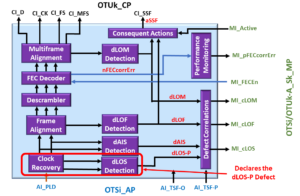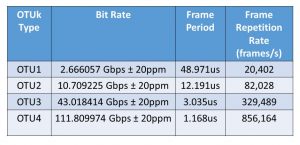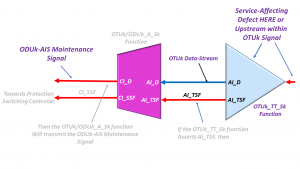What is Defect Correlation, and How Should You Interpret It?
The purpose of this blog post is two-fold.
- To describe the concept of Defect Correlation and
- To discuss how to interpret the meaning of Defect Correlation and their Equations.
Introduction
Numerous ITU Standards (such as ITU-T G.798 for OTN applications) will define various aspects of defects. These standards will define a defect, such as dLOS (the Loss of Signal) and dLOF (the Loss of Frame).
These standards will (sometimes) describe the conditions that an OTN Network Element (be it an STE or PTE) should use to declare or clear a given defect.
For instance, ITU-T G.798 specifies all of the following defects that an OTN STE can declare and clear.
(*) – Requires membership to THE BEST DARN OTN TRAINING PRESENTATION…PERIOD!!! to see these links.
And it is excellent that the ITU-T standard committee does this for us.
But let’s now take a closer look at these defects from a System-Level standpoint.
Should One Defect Lead to Many Other Defects?
Suppose an OTN STE declares the dLOS-P (Loss of Signal-Path) defect condition with its incoming optical lanes or signal.
This STE will declare the dLOS-P condition for one of two reasons.
- Because the optical components (upstream) are detecting too little optical signal energy (within the incoming signal) or
- the Clock and Data Recovery circuitry (within the STE electronics) is detecting an absence of recovered (data) signal activity for an extended period.
In Figure 1, I illustrate the OTSi/OTUk-a_A_Sk function, declaring the dLOS-P defect.

Figure 1, The OTSi/OTUk-a_A_Sk Atomic Function, declares the dLOS Defect Condition.
In either of these cases, it is clear that this OTN STE should declare the dLOS-P defect condition.
How about the dLOF Condition?
However, if that same OTN STE is not receiving any discernable signal from the remote STE, it is safe to say that it will not be receiving the FAS fields (within this now non-existent incoming data stream).
Should this OTN STE also declare the dLOF defect as well?
In Figure 2, I illustrate the OTSi/OTUk-a_A_Sk function, declaring the dLOF defect condition and the dLOS-P defect condition.

Figure 2, The OTSi/OTUk-a_A_Sk function declaring the dLOF and dLOS-P Defect Conditions
Clueless about OTN? We Can Help!! Click on the Banner Below to Learn More!!!
Corporate Discounts Available!!!

What about the dLOM Condition?
And since the OTN STE is not receiving any FAS field bytes, it cannot locate the MFAS bytes.
Should this OTN STE also declare the dLOM defect too?
In Figure 3, I illustrate the OTSi/OTUk-a_A_Sk function, declaring the dLOM, dLOF, and dLOS-P Defect conditions.

Figure 3, The OTSi/OTUk-a_A_Sk Atomic Function declaring the dLOM, dLOF, and dLOS-P Defect Conditions
How about the dTIM Condition?
Finally, since our OTN STE is not receiving any discernable signal (from the remote STE), and it cannot locate the boundaries of each incoming OTUk frame, it will certainly not obtain a Trail Trace Identification Message that matches that of the “Expected Trail Trace Identification” Message.
Should this OTN STE also declare the dTIM defect as well?
In Figure 4, I illustrate the OTUk_TT_Sk function declaring the dTIM defect, while the upstream OTSi/OTUk-a_A_Sk function reports the dLOS-P, dLOF, and dLOM defect conditions.

Figure 4, The OTUk_TT_Sk Atomic Function (downstream from the OTSi/OTUk-a_A_Sk Function) declares the dTIM defect.
Many Defects, all due to the dLOS-P Condition
In this scenario, a Loss of Signal event would cause the OTN STE to declare the dLOS, dLOF, dLOM, and dTIM defect conditions.
The OTN STE will accurately declare all four defect conditions because conditions warrant that the STE declare each of these defects.
However, allowing an STE to declare multiple defects (e.g., dLOS, dLOF, dLOM, and dTIM) can be confusing to both System-Management and the System Operator.

I could take this exercise even further and include some of the PTE/ODUk-related defects that an OTN PTE would declare (e.g., ODUk-AIS), all because of the dLOS-P condition. But I think that you get my point.
Whenever a service-affecting defect occurs, the OTN STE needs to alert System Management of a concise description of the problem (just dLOS-P in this case).
The intent should be to help the System Operator isolate the root cause of these problems.
We should not be bombarding the System Operator with a whole slew of defects, which are just artifacts of a single defect.
If the OTN STE declares the dTIM, dLOM, dLOF, and dLOS-P defects, the root cause of this problem has nothing to do with a mismatch in the Trail-Trace Identification Message.
Hence the Purpose of Defect Correlation
The purpose of Defect Correlation and Defect Correlation equations is to establish and report ONLY the root cause of problems to System Management.
The Defect Correlation Equations accomplishes this by creating a hierarchy of defects.
I’ll explain this.
Let’s list some Defect Correlation Equations for the OTSi/OTUk_A_Sk and OTUk_TT_Sk Atomic Functions.
For the OTSi/OTUk_A_Sk Atomic Function
The OTSi/OTUk_A_Sk function has the following Defect Correlation equations:
- cLOS-P ⇐ dLOS-P and (NOT AI_TSF-P)
- cLOF ⇐ dLOF and (NOT dLOS-P) and (NOT dAIS) and (NOT AI_TSF-P)
- cLOM ⇐ dLOM and (NOT dLOS-P) and (NOT dLOF) and (NOT dAIS) and (NOT AI_TSF-P)
Let’s also include the following Consequent Equation to bridge the OTUk_TT_Sk function to the OTSi/OTUk_A_Sk function.
aSSF ⇐ dLOS-P or dAIS or dLOF or dLOM or AI_TSF-P
For the OTUk_TT_Sk Function
In this case, we will focus on the Defect Correlation equation that pertains to the dTIM defect condition.
- cTIM ⇐ dTIM and (NOT CI_SSF) and (NOT dAIS)
So Now Let’s Study some of these Defect Correlation Equations
Let’s start with the first equation for the OTSi/OTUk-a_A_Sk function.
-
cLOS-P ⇐ dLOS-P and (NOT AI_TSF-P)
Where:
cLOS-P is the correlated defect value of the dLOS-P defect state.
dLOS-P is the current state of the dLOS-P defect condition that the OTSi/OTUk_A_Sk function will declare or clear.
AI_TSF-P is the current state of the AI_TSF-P (Trail Signal Fail – Path Indicator) Input to the OTSi/OTUk-A_Sk function.
In this equation, the parameter that begins with the letter “c” is the correlated defect parameter (or defect) state that we ultimately report to System Management.
This equation states that we should only set the variable cLOS-P to TRUE if dLOS-P is TRUE.
In other words, we should only report the Loss of Signal condition (e.g., setting cLOS-P to TRUE) if the STE circuitry declares the dLOS-P defect (due to a lack of signal activity within the Clock Recovery Block, for example).
This equation also states that we should NOT set cLOS-P to TRUE because the upstream Optical Circuitry is declaring some other defect condition and is then asserting its AI_TSF-P output – towards the OTSi/OTUk_A_Sk function).
I show a TRUTH TABLE for this Defect Correlation Equation below in Table 1.
Table 1, TRUTH TABLE for the Defect Correlation Equation, cLOS-P ⇐ dLOS-P AND (NOT AI_TSF-P)
| dLOS-P Defect | AI_TSF-P State | cLOS-P State | Comment |
| Cleared | FALSE | 0 | |
| Declared | FALSE | 1 | Sets cLOS-P to TRUE, because dLOS-P is declared. |
| Don't Care | TRUE | 0 | We set cLOS-P to 0 when AI_TSF-P is TRUE. |
Let’s look at another Defect Correlation Equation.
-
cLOF ⇐ dLOF and (NOT dLOS-P) and (NOT dAIS) and (NOT AI_TSF-P)
Where:
cLOF is the correlated value of the dLOF defect state.
dAIS is the current state of the dAIS defect condition within the OTSi/OTUk_A_Sk function.
In this equation, we are stating that we should only set cLOF = TRUE (and report the Loss of Frame condition to System Management) if the STE circuitry declares the dLOF condition.
This equation also states that we should NOT be setting cLOF = TRUE (and report the Loss of Frame Condition to System Management) if:
- The STE is also declaring the dLOS-P defect, or
- declaring the dAIS (OTUk-AIS) defect, or
- If the upstream Optical Components assert the AI_TSF-P input to the OTSi/OTUk_A_Sk function.
If any of the three items (above) are TRUE, then we must set cLOF = FALSE.
I show the TRUTH TABLE for this Defect Correlation Equation below in Table 2.
Table 2, The TRUTH TABLE for the Defect Correlation Equation, cLOF ⇐ dLOF AND (NOT dLOS-P) AND (NOT dAIS) AND (NOT AI_TSF-P)
| dLOF Defect Condition | dLOS-P Defect Condition | dAIS Defect Condition | AI_TSF-P State | cLOF State | Comments |
| Cleared | Cleared | Cleared | FALSE | Cleared | |
| Declared | Cleared | Cleared | FALSE | Declared | We assert cLOF because we are declaring the dLOF Defect |
| Don't Care | Declared | Cleared | FALSE | Cleared | We set cLOF = 0 whenever dLOS-P is declared. |
| Don't Care | Cleared | Declared | FALSE | Cleared | We set cLOF = 0 whenever dAIS is declared. |
| Don't Care | Cleared | Cleared | TRUE | Cleared | We set cLOF = 0 whenever AI_TSF-P is driven TRUE. |
At the risk of “whipping a dead horse,” I will show one more example.
-
cTIM ⇐ dTIM and (NOT CI_SSF) and (NOT dAIS)
Where:
cTIM is the correlated value of the dTIM defect state.
CI_SSF is the current state of the CI_SSF (Server Signal Fail Indicator) input pin to the OTUk_TT_Sk function.
If the STE circuitry declares this defect, this equation states that we must only report the Trail Trace Identifier Mismatch Defect (and set cTIM = TRUE).
This equation also states that we MUST NOT set cTIM = TRUE if any of the following is true.
NOTE: We have the following Consequent Equation for the CI_SSF signal (from the OTSi/OTUk_A_Sk function).
- aSSF <- dLOS-P or dAIS or dLOF or dLOM or AI_TSF-P
This equation states that if the upstream OTSi/OTUk_A_Sk function declares any of the following defects, it will set aSSF = TRUE.
- dLOS-P
- dAIS (OTUk-AIS)
- dLOF
- dLOM, or
- If the upstream Optical Components assert the AI_TSF-P input to the OTSi/OTUk_A_Sk function.
If aSSF = TRUE, then the OTSi/OTUk_A_Sk function will assert the CI_SSF output signal (towards the OTUk_TT_Sk function).
Finally, we get to the bottom line.
These equations state that the STE MUST NOT set cTIM = TRUE (and MUST NOT report the Trail Trace Identifier Mismatch defect to System Management) if any of the following defect conditions are TRUE.
- dLOS-P
- dAIS
- dLOF
- dLOM
- If the AI_TSF-P signal (from the upstream Optical Components) is HIGH.
Summary
I believe that you can see that using Defect Correlation Equations makes Defect Reporting and System-Management MUCH EASIER.
Has Inflation got You Down? Our Price Discounts Can Help You Fight Inflation and Help You Become an Expert on OTN!! Click on the Banner Below to Learn More!!!
Discounts Available for a Short Time!!

CLICK on the Image below for More OTN Related Blog Posts

OTN Related Topics within this Blog General Topics Consequent Equations - What are they and How can you use them? ...

















